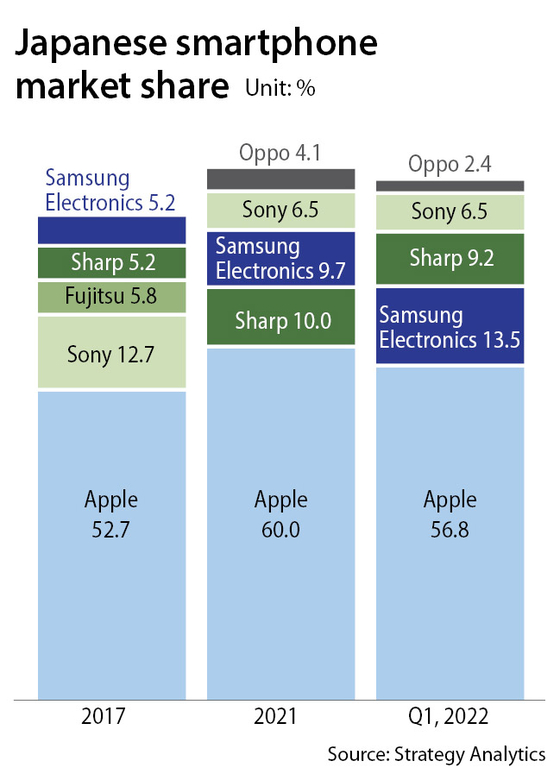Samsung's Galaxy phones become a hit in Japan
이 글자크기로 변경됩니다.
(예시) 가장 빠른 뉴스가 있고 다양한 정보, 쌍방향 소통이 숨쉬는 다음뉴스를 만나보세요. 다음뉴스는 국내외 주요이슈와 실시간 속보, 문화생활 및 다양한 분야의 뉴스를 입체적으로 전달하고 있습니다.
![Samsung Electronics Galaxy store in Harajuku, Tokyo. [NEWS1]](https://img4.daumcdn.net/thumb/R658x0.q70/?fname=https://t1.daumcdn.net/news/202205/18/koreajoongangdaily/20220518185655227awbm.jpg)
Japan was once a graveyard for Korean smartphone sales, but Samsung Electronics is rising from that grave with popular foldable models and the latest Galaxy S devices.
Galaxy-brand smartphones are now second in market share after Apple iPhones, vanquishing the once-mighty Japanese brands Sharp and Sony.
Samsung Electronics claimed 13.5 percent of the Japanese market in the first quarter, its highest level since the first quarter in 2013, according to market tracker Strategy Analytics. Local competitors were far behind: Sharp had 9.2 percent and Sony 6.5 percent.
Apple has undisputed dominance in Japan, claiming 56.8 percent market share.
Over the past few years, Samsung had single digit market share, eclipsed by Apple on the high-end and by Japanese and Chinese rivals in budget models.

Its market share was 5.2 percent in 2017, which edged up to 6.4 percent the next year and 7.8 percent in 2019. The electronics maker saw a big increase to 10.1 percent in 2020, the year that it released the Galaxy S20 series and the Z Flip and Z Fold2.
Last year, market share dwindled to 9.7 percent, down 0.4 percentage points from the year before.
Apple has maintained the biggest market share in Japan. In 2017, the U.S. manufacturer had 52.7 percent, which rose to 60 percent in 2021 and fell to 56.8 percent in the first quarter of this year.
Sony’s share almost halved between 2017 and the first quarter of 2022: from 12.7 percent to 6.5 percent. Osaka-based Sharp saw its share grow from 5.2 percent to 9.2 percent in the same period.
Samsung's rebound is driven by strong sales across the board including foldables, the flagship Galaxy S and budget A lines.
“When the economy is in trouble, people tend to look for budget smartphones with decent quality,” an industry source said. “And the Z Flip range appears to appeal to Japanese consumers who are fond of petite and cute design.”
In the past, Samsung Electronics has tried to avoid promoting its corporate name in Japan; it was concerned about anti-Korea sentiment. In 2016, it removed the company name from retail stores, its official website and Twitter too, only mentioning the Galaxy brand.
Another notable change is the absence of Chinese vendor Huawei, which held a 5.2 percent share in 2018. Huawei suffered a significant drop in the global smartphone market after the United States cut it off from supplies of advanced chips based on U.S. technology. Dongguan, Guangdong-based Oppo has filled the gap, with 4.1 percent market share last year.
In the global market, Samsung Electronics recaptured the market share crown in the first quarter of this year.
“We estimate Samsung shipped 75 million smartphones and topped the global smartphone market with a healthy 24 percent share in Q1 2022,” said Woody Oh, director at Strategy Analytics.
“It is the vendor’s highest first quarter performance by market share since 2017," he said. "Demand was strong for the newly launched flagship Galaxy S22 series, especially the higher-priced S22 Ultra model.” Apple took second place with 18 percent in the first quarter, although it controlled the highest first quarter market share in the global market from 2013 to 2021.
BY PARK EUN-JEE, CHOI EUN-KYUNG [park.eunjee@joongang.co.kr]
Copyright © 코리아중앙데일리. 무단전재 및 재배포 금지.
- Bullying allegations against Le Sserafim's Kim Ga-ram escalate
- Biden to visit Samsung Electronics chip factory during visit
- New KBS drama 'Tell Me Your Wish' to air in August
- Costs of Luna collapse still being counted in Korea
- Stray Kids to drop new EP 'Circus' in Japan on June 22
- Rhee Ken 'expects to be arrested' upon his return to Korea
- K-pop fans left biting their nails in anticipation of the 'seven-year curse'
- It was just simple math, Luna short seller says after coin's fall
- North Korea flies in supplies from China
- PSY hopes to see success with debut of first boy band TNX